S279 point mutations in Candida albicans Sterol 14-α demethylase (CYP51) reduce in vitro inhibition by fluconazole
- PMID: 22252802
- PMCID: PMC3318376
- DOI: 10.1128/AAC.05389-11
S279 point mutations in Candida albicans Sterol 14-α demethylase (CYP51) reduce in vitro inhibition by fluconazole
Abstract
The effects of S279F and S279Y point mutations in Candida albicans CYP51 (CaCYP51) on protein activity and on substrate (lanosterol) and azole antifungal binding were investigated. Both S279F and S279Y mutants bound lanosterol with 2-fold increased affinities (K(s), 7.1 and 8.0 μM, respectively) compared to the wild-type CaCYP51 protein (K(s), 13.5 μM). The S279F and S279Y mutants and the wild-type CaCYP51 protein bound fluconazole, voriconazole, and itraconazole tightly, producing typical type II binding spectra. However, the S279F and S279Y mutants had 4- to 5-fold lower affinities for fluconazole, 3.5-fold lower affinities for voriconazole, and 3.5- to 4-fold lower affinities for itraconazole than the wild-type CaCYP51 protein. The S279F and S279Y mutants gave 2.3- and 2.8-fold higher 50% inhibitory concentrations (IC₅₀s) for fluconazole in a CYP51 reconstitution assay than the wild-type protein did. The increased fluconazole resistance conferred by the S279F and S279Y point mutations appeared to be mediated through a combination of a higher affinity for substrate and a lower affinity for fluconazole. In addition, lanosterol displaced fluconazole from the S279F and S279Y mutants but not from the wild-type protein. Molecular modeling of the wild-type protein indicated that the oxygen atom of S507 interacts with the second triazole ring of fluconazole, assisting in orientating fluconazole so that a more favorable binding conformation to heme is achieved. In contrast, in the two S279 mutant proteins, this S507-fluconazole interaction is absent, providing an explanation for the higher K(d) values observed.
Figures

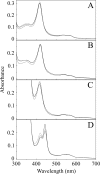
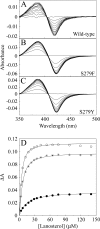
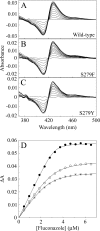
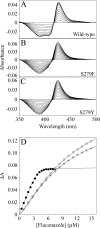
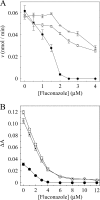


Similar articles
-
Azole binding properties of Candida albicans sterol 14-alpha demethylase (CaCYP51).Antimicrob Agents Chemother. 2010 Oct;54(10):4235-45. doi: 10.1128/AAC.00587-10. Epub 2010 Jul 12. Antimicrob Agents Chemother. 2010. PMID: 20625155 Free PMC article.
-
The Evolution of Azole Resistance in Candida albicans Sterol 14α-Demethylase (CYP51) through Incremental Amino Acid Substitutions.Antimicrob Agents Chemother. 2019 Apr 25;63(5):e02586-18. doi: 10.1128/AAC.02586-18. Print 2019 May. Antimicrob Agents Chemother. 2019. PMID: 30783005 Free PMC article.
-
Azole affinity of sterol 14α-demethylase (CYP51) enzymes from Candida albicans and Homo sapiens.Antimicrob Agents Chemother. 2013 Mar;57(3):1352-60. doi: 10.1128/AAC.02067-12. Epub 2012 Dec 28. Antimicrob Agents Chemother. 2013. PMID: 23274672 Free PMC article.
-
Screening for amino acid substitutions in the Candida albicans Erg11 protein of azole-susceptible and azole-resistant clinical isolates: new substitutions and a review of the literature.Diagn Microbiol Infect Dis. 2010 Apr;66(4):373-84. doi: 10.1016/j.diagmicrobio.2009.11.006. Diagn Microbiol Infect Dis. 2010. PMID: 20226328 Review.
-
Current advancements and future perspectives of 1,2,3-triazoles to target lanosterol 14α-demethylase (CYP51), a cytochrome P450 enzyme: A computational approach.Int J Biol Macromol. 2025 Jun;315(Pt 1):144240. doi: 10.1016/j.ijbiomac.2025.144240. Epub 2025 May 17. Int J Biol Macromol. 2025. PMID: 40389011 Review.
Cited by
-
Steroids hydroxylation catalyzed by the monooxygenase mutant 139-3 from Bacillus megaterium BM3.Acta Pharm Sin B. 2017 Jul;7(4):510-516. doi: 10.1016/j.apsb.2017.04.006. Epub 2017 May 4. Acta Pharm Sin B. 2017. PMID: 28752038 Free PMC article.
-
Reduced Susceptibility to Azoles in Cryptococcus gattii Correlates with the Substitution R258L in a Substrate Recognition Site of the Lanosterol 14-α-Demethylase.Microbiol Spectr. 2023 Aug 17;11(4):e0140323. doi: 10.1128/spectrum.01403-23. Epub 2023 Jun 21. Microbiol Spectr. 2023. PMID: 37341584 Free PMC article.
-
Antifungal Activity of Fibrate-Based Compounds and Substituted Pyrroles That Inhibit the Enzyme 3-Hydroxy-methyl-glutaryl-CoA Reductase of Candida glabrata (CgHMGR), Thus Decreasing Yeast Viability and Ergosterol Synthesis.Microbiol Spectr. 2022 Apr 27;10(2):e0164221. doi: 10.1128/spectrum.01642-21. Epub 2022 Apr 4. Microbiol Spectr. 2022. PMID: 35377226 Free PMC article.
-
Repurposing FDA-Approved Drugs for Eumycetoma Treatment: Homology Modeling and Computational Screening of CYP51 Inhibitors.Int J Mol Sci. 2025 Jan 1;26(1):315. doi: 10.3390/ijms26010315. Int J Mol Sci. 2025. PMID: 39796172 Free PMC article.
-
A New Variant of Mutational and Polymorphic Signatures in the ERG11 Gene of Fluconazole-Resistant Candida albicans.Infect Drug Resist. 2022 Jun 17;15:3111-3133. doi: 10.2147/IDR.S360973. eCollection 2022. Infect Drug Resist. 2022. PMID: 35747333 Free PMC article.
References
-
- Altschul SF, Gish W, Miller W, Myers EW, Lipman DJ. 1990. Basic local alignment search tool. J. Mol. Biol. 215:403–410 - PubMed
-
- Arase M, Waterman MR, Kagawa N. 2006. Purification and characterization of bovine steroid 21-hydroxylase (P450c21) efficiently expressed in Escherichia coli. Biochem. Biophys. Res. Commun. 344:400–405 - PubMed
-
- Bancel F, Bec N, Ebel C, Lange R. 1997. A central role for water in the control of the spin state of cytochrome P-450scc. Eur. J. Biochem. 250:276–285 - PubMed
-
- Bellamine A, Lepesheva GI, Waterman MR. 2004. Fluconazole binding and sterol demethylation in three CYP51 isoforms indicate differences in active site topology. J. Lipid Res. 45:2000–2007 - PubMed
Publication types
MeSH terms
Substances
Grants and funding
LinkOut - more resources
Full Text Sources

